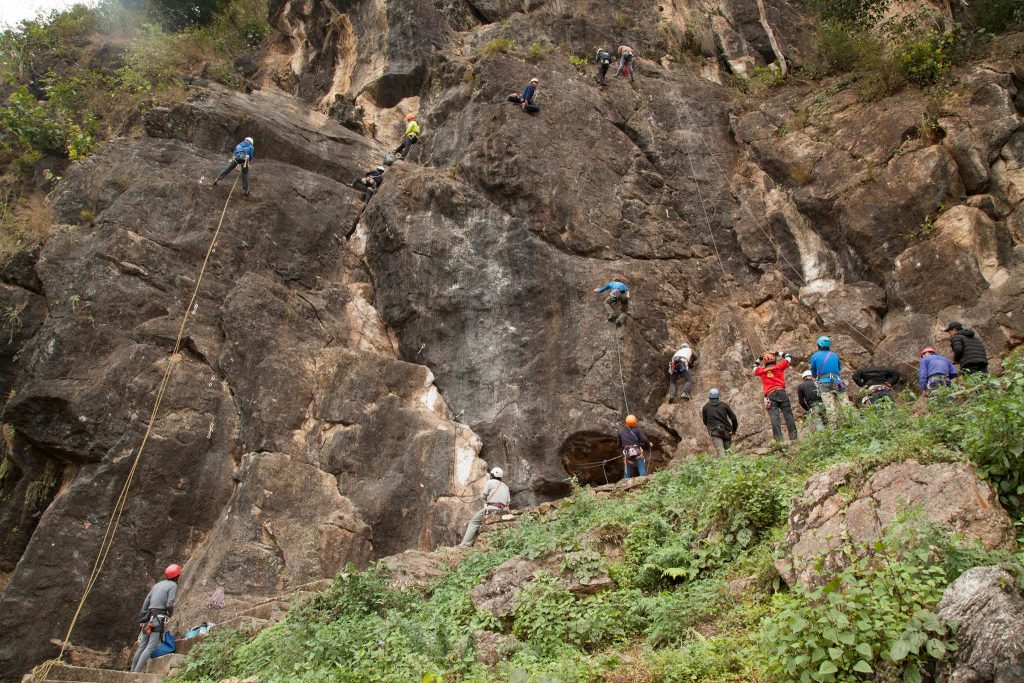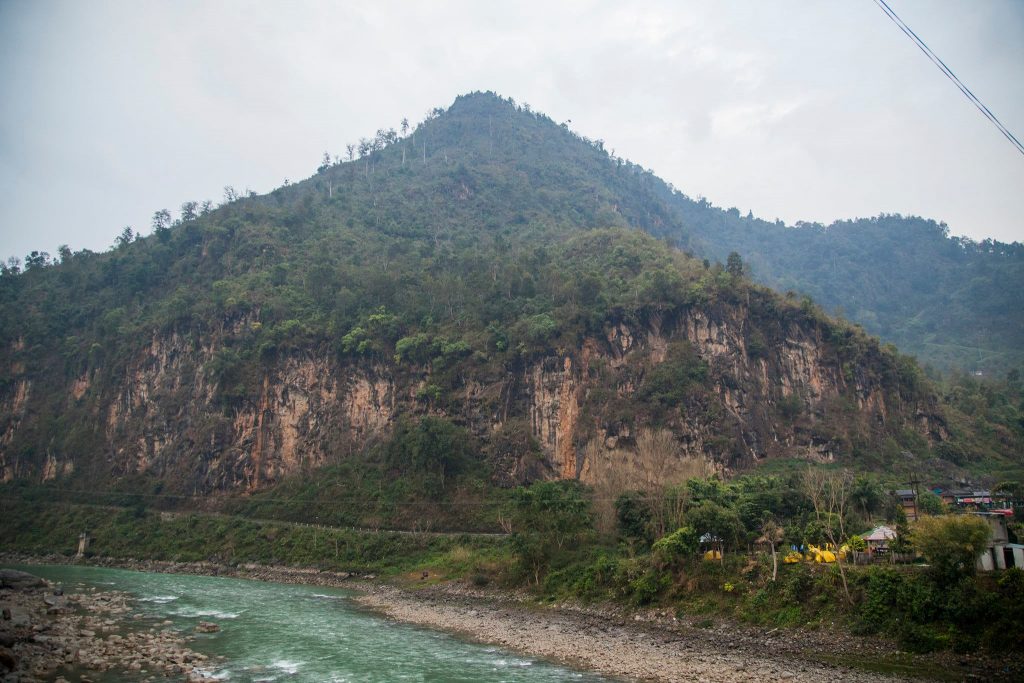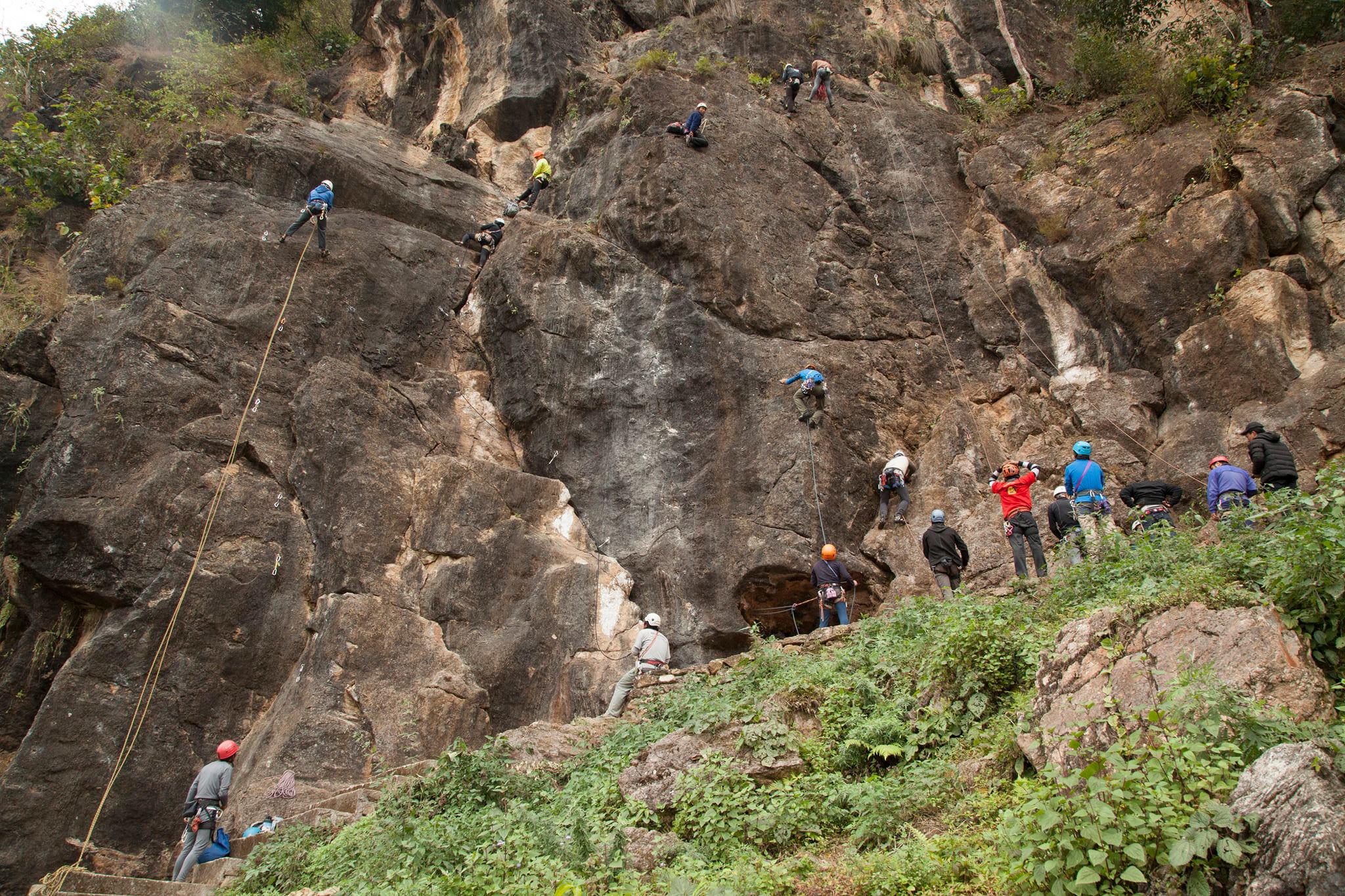
Bikash Gurung was rock climbing at Bimalnagar, Bandipur of Tanahun in April when he saw a few people with a tape measuring the distance from the Prithvi Highway to the climbing rock. Seeing people who were not climbing approach the rock, Gurung and a few of his friends, who were also climbing, got down and approached the officials.
“They told us they were a part of the road expansion team doing the measurements for a pre-feasibility study,” says Gurung.
The officials told them that as plans were in place to extend the highway from Mugling to Damauli and that as per the plan, it was likely that parts of the climbing rock would be affected during the extension.
“We were shocked when they told us that it might be gone when the road expansion takes place,” says Gurung.
This has caused an uproar within the climbing community of Nepal that feels it would be detrimental for the sport’s future in Nepal. The locals have also shown concern as the rock has had a positive impact on the community as the area, even though it is home to Siddha Cave, supposedly the second largest cave in South Asia, is known only because of the climbing rock.
Centre of attraction
“This is the area’s jewel; we will do everything we can to stop it from being demolished,” says Dhan Bahadur Thapa, ward number 4 chair of Bandipur rural municipality. “We’ve been holding talks with the centre and hopefully we might be able to find a way to save the rock.”

Various meetings, both online and in-person, have taken place as local leaders and stakeholders have been trying to explain to the authorities the need to save the rock, which for the past 15 years has been a centre of the universe for rock climbing in Nepal.
“The Chinese company building the road has promised it will try its best to save it,” says Purna Singh Thapa Magar, the chairman of Bandipur rural municipality. “There are chances that two routes might be affected, but they’ve also promised that they will build a better route if they have to demolish one.”
Magar, however, says that demolishing the routes will be the last resort as they are talking about other alternatives.
“I know what this place means to people and am all for saving it,” says Magar.
Every year, this place sees thousands of people. Some come to climb for leisure while others climb to train themselves as the wall is used by Nepal National Mountain Guide Association and Nepal Mountaineering Instructors Association to train mountain guides.
Local Lal Kumar Shrestha, who owns a guesthouse opposite the rock, says army and police personnel also use the rock for their yearly training.
“It’s a place for everyone. It has routes for beginners and for pro athletes. It would be a shame if anything happened to this. We will not let anything happen,” says Shrestha.
Development of the place
The rock was set up in 2006 by mountain guides Prem Gurung and friends in memory of Iman Grung, a mountaineer, instructor and adventurer who lost his life after being buried in an avalanche at Kang Garu in the Nar Phu valley in the Annapurna region. Since then, the rock has been a boon to anyone who is involved in mountaineering or adventure sport.
Its popularity rose in the 2010s after various mountaineering organisations started to train people there while a few also held competitions there. One person who took part in them was Niraj Karki, a former national champion and adventurer. Karki says it would be foolish to kill the wall which has been a climber’s paradise.
“If you ask any climber, they’ll tell you how important that place is. It’s invaluable for so many reasons and we need to do everything we can to save it,” says Karki.
The crag, according to Prem Gurung, is perfect for rock climbing as it is composed of limestone which is erosion-resistant and has durable surfaces making it easy to establish a new route on the cliff. The other reason, according to Prem, is its accessibility.
“It’s only 130 km from Kathmandu and 60 km from Pokhara,” says Prem Gurung. “There have been other walls in Kathmandu, but those aren’t as accessible as this one where tourists, climbers and adventurers can come spend a few days and leave. It was a win-win for all.”
The place has around 30 routes which have been divided into various grades. Some routes are harder than others as they are suitable for beginners to professionals. The wall is also is hope to Nepal’s first multi-pitch route.
“We use it to train ourselves before we go the mountain or to train young and upcoming climbers,” says Prem Gurung. “The place has a special place in the hearts of everyone who’ve known Iman and who’ve climbed here.”
Efforts to save it
Efforts have started from the locals and stakeholders as they have written to both the central and the provincial sports ministries, National Sports Council, Provincial Sports Council, District Administration Office, Bandipur rural municipality, the district’s sports development committee and the road expansion project.
“We’ve highlighted why this place is important in the letters we’ve written to them,” says Sujit Kandel, a member of the Bimalnagar Rock Climbing Conservation Committee. “We’ve had a positive response, but this is going to be a long battle for which we will have to be patient.”

He says that both the committee and the community understand it is a pride project and that the expansion should take place. But, Kandel adds that alternatives must be looked at before things move forward.
“It’s a pre-feasibility study and things can be amended, I’m sure. We’ve also suggested alternatives which can be taken into consideration by the road team,” says Kandel.
The recommendations include a request to reconsider expanding the area around Bimalnagar which they argue should be considered given that it is expected to affect a lot of people and organisations. The second recommendation includes shifting the highway towards the river.
“Looking back at what’s happened this monsoon, it might not be an ideal plan but they can see if that can be done,” adds Kandel.
The final recommendation they have given to the government is to make an alternative track to avoid the wall section completely.
“We hope they can consider this,” says Kandel.
Local Shrestha, on the other hand, says the authorities and the people who have been assigned the project want to target the rock and demolish it for mining.
“I’ve heard they want to mine the place for uranium and other minerals. The project is being handled by the Chinese and they’ve been telling how they want to extend the area 50 metres rather than 25 metres. If they do that, we will not stay quiet because this place means a lot to us,” says Shrestha.
However, rural municipality chair Magar says whatever Shrestha says is not entirely true as they also plan to make restaurants and other attractions near the wall.
“The Chinese have brought a plan to make the place attractive and I think the locals need to entertain some ideas,” he says.
The locals, however, do not trust the Chinese as they feel that they will do more harm than good.
“If they even think about damaging the rock, there will be retaliation,” says Shrestha.
But, for climbers like Karki, resorting to violence is not the answer as he feels that Iman’s legacy might be tarnished due to it.
“There is no alternative to Bimalnagar and that is what the major problem is right now. Authorities need to understand this because this place is historic,” says Karki. “The sad part is, if the authorities do demolish the place, people will not realise what we have lost.”




















